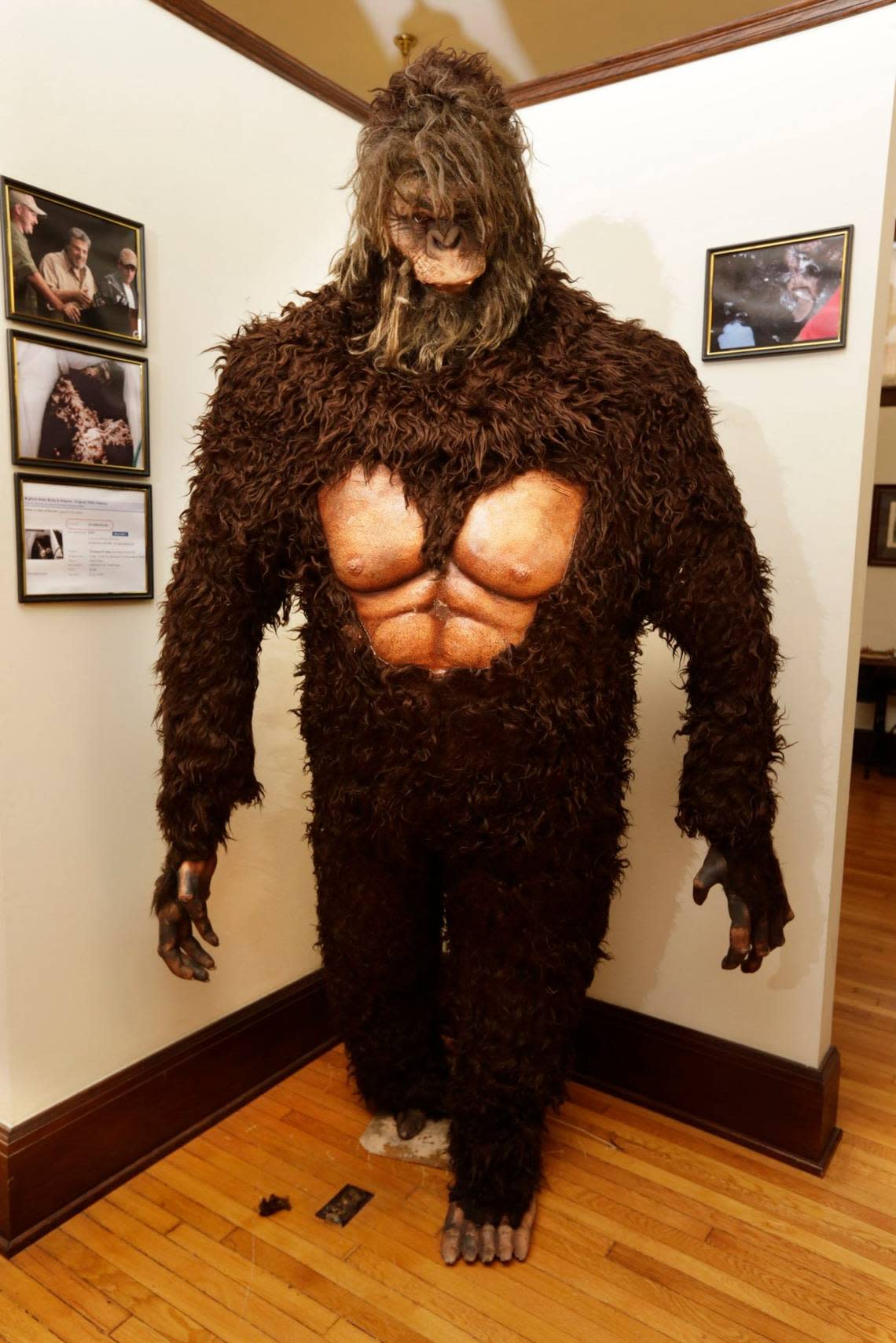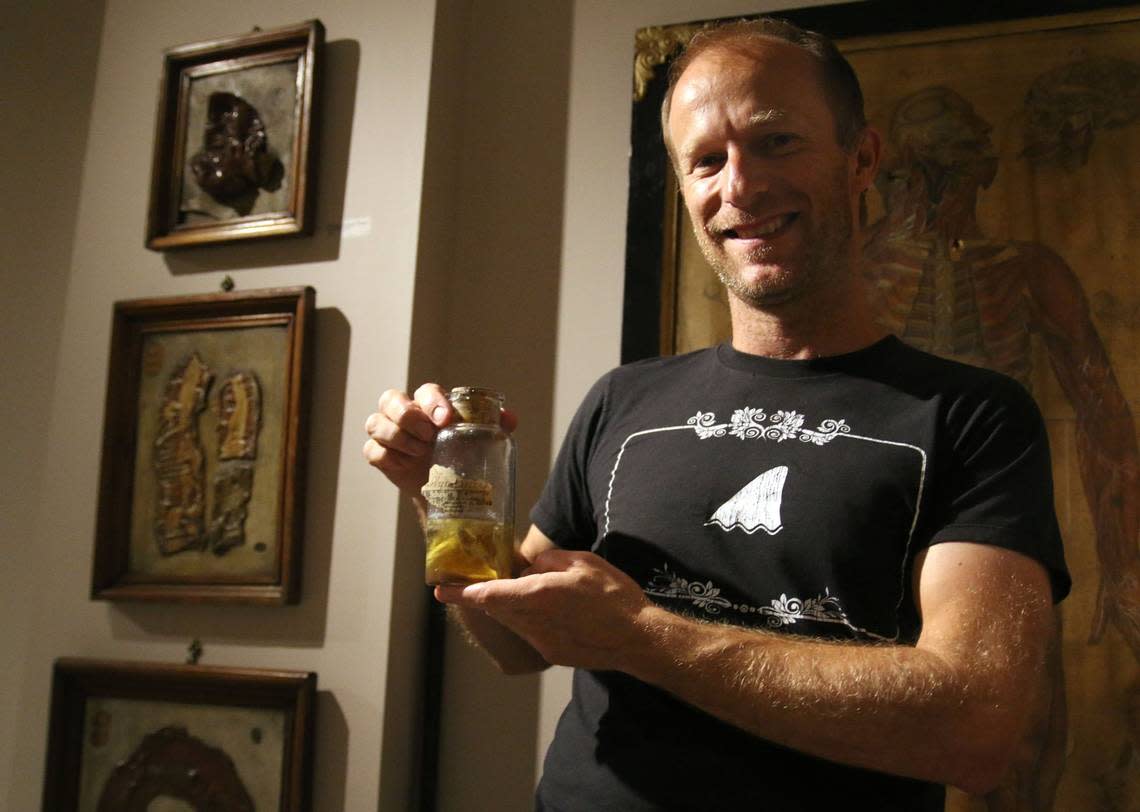Cryptids of the commonwealth: Meet some of these creatures who have been spotted in KY
Giraffe-possums, lizards and Mothman, oh my! Kentucky is reportedly home to a score of cryptids and unknown creatures, and why shouldn’t they live here? We have a wonderful state with the amenities for anything (or anyone) that might go bump in the night.
I’ve gathered a baker’s dozen of cryptids from across the Bluegrass State. In no way is this meant to be an exhaustive list; after all, saying this is a definitive list of Kentucky cryptids runs afoul of the entire point of the mysteries of these creatures.
Most of the information on these cryptids was compiled by Ron Coffey who wrote the book, “Kentucky Cryptids: ‘Monsters’ of the Bluegrass State.” Coffey has authored several books on cryptozoology and the paranormal. He’s also the co-founder of The Gateway Paranormal Society, which is based out of Mount Sterling.
Kudos to Coffey and all the other cryptozoologists and investigators out there for putting in the hours to learn about the unknown and then sharing that information. Check out his book from your local library, or buy it yourself if you can.
Without further ado, here are, in no particular order, 13 Kentucky cryptids you should know about.
The Pope Lick Monster
This Louisville-centric cryptid has been known to take on the form of a creature that is half-man and half-goat (sometimes called the Goat Man), half-man and half-sheep, or a hybrid that is also headless, according to folklore. As the legend goes, the monster lives on top of the Pope Lick Trestle, a railway bridge over Pope Lick Creek, and lures people to the top of the trestle where they meet an untimely end.
While the Pope Lick Monster is fictitious, the tragic thing about this story is that some people have sadly lost their lives to the myth. So please do not go up on the tracks; your life is more important than the pursuit of the paranormal.
Mothman
Yes, I know West Virginia has a strong claim to fame for Mothman; Point Pleasant has an entire festival dedicated to Mothman, which has created a largely successful cryptid-based economy. (Also, anyone out there running for Kentucky governor next year, feel free to make “cryptid-based economy” part of your campaign platform.)
While Mothman has strong roots in Kentucky’s neighboring state, that doesn’t preclude the cryptid, or cryptids (can’t exclude the possibility of Mothpeople!), from making an appearance in the commonwealth.
As the story goes, the part moth-part man was first spotted in the area of Point Pleasant, West Virginia beginning in 1966 and had a spate of somewhat consistent sightings in the area until 1967. The creature has been described as a “flying man with 10-foot wings,” about seven feet tall with large, red eyes.
According to Coffey’s book, the first reported sighting of Mothman in Kentucky was in Mount Sterling in November 1868 where “around 30 inhabitants of the area reported seeing the creature sitting on top of the Old Farmers Bank building.” Mothman was again spotted in Ashland in March 1938 and more recent sightings in Pikeville were reported in 2008.

Sheepsquatch
Somewhere along Bigfoot’s family tree you’ll find this soft, cuddly cryptid: the Sheepsquatch. Half man, half sheep (self-explanatory), this cryptid of the commonwealth has been spotted in Breckenridge County, has received a write-up in the paper of record and was the focus of the series premiere of “Monsters and Mysteries in America” on Destination America.
That episode tells the story of Dakota Cheeks and Ricky Joyce, who say they encountered Sheepsquatch on a hunting trip in 2004. Described as “a crossover between mutton and man,” this furry cryptid is sadly outshined by the more well-known Sasquatch.
Bigfoot
C’mon, we all know Bigfoot. In terms of cryptids, Bigfoot is like the OG. Do I even need to explain Bigfoot to you, I mean really? You either grew up with a Bigfoot obsession or you still actively have one and there’s no in-between.
According to Coffey, Bigfoot is by far the most reported cryptid in Kentucky and of the 50 U.S. States our fine commonwealth rates at number 15 in reported sightings.
The most famous Bigfoot encounter in Kentucky’s history, Coffey says, was in 1782 and involved the one and only Daniel Boone.

Bearilla
Despite the name, Bearilla is not, as one might assume, the cross between a bear and a gorilla. Instead the cryptid boasts the body of a bear and features of a wolf, Coffey told Wave 3 back in 2012.
The reason for this naming convention mishap is traced back to the first sighting of Bearilla in Nicholas County in 1972, according to Coffey’s book. A 76-year-old man, who was driving to his barn to check on tobacco one early morning, reported seeing Bearilla cross in front of him on a rural Nicholas County road and described it as having “a dog-like head, standing 6 to 7 feet in height, covered in long, matted white hair and walking with a very pronounced shoulder stoop.”
In news interviews, the man described the “critter” as half bear and half gorilla, and the name has stuck ever since.
Little Green Men of Kelly
The Kelly Green Men, also called the Hopkinsville Goblins, are part of a well-known incident that happened in 1955 in Christian County. As the legend goes, the Sutton family experienced a close encounter with potential extraterrestrials, or “little green men,” on their small farm out in Kelly.
The family’s story, in which they claim to have been under siege by the aliens as they held them off for several hours, is notable for the number of witnesses involved, duration of the encounter and the proximity between the family and the creatures.
This is also another instance where the cryptid-based economy scores a win as the town of Kelly hosts a festival commemorating the event.
Kentucky meat shower
OK, this one isn’t a cryptid, I know, but hear me out. In March 1876, meat rained down from the sky in Bath County. Two brave men, who were surely the scientists of their time, tasted the meat that fell from the sky and reported it was “either mutton or venison.”
Was the meat shower caused by a cryptid in some way? Likely not, as projectile vulture vomit seems to be the culprit. But why attribute to vulture vomit what can be attributed to the unknown? For this reason the meat shower makes an honorary appearance on the list.

Beast Between the Lakes
The Beast of the Land between the Lakes is said to look like a bipedal wolf, according to local radio station WKDZ, standing around 7 feet tall and “sporting clawed hands, powerful jaws with wicked teeth, glowing red eyes, and cloaked in a fetid, rotting stench.”
This cryptid calls the area between Lake Barkley and Kentucky Lake in the western portion of the commonwealth near the Tennessee border home. This cryptid also intersects with some particular history of the area. To create the Land Between the Lakes National Recreation Area, the Tennessee Valley Authority exercised eminent domain, displacing nearly 1,000 families from the land.
As WKMS reports, some of the natives from the area don’t take kindly to the idea of the Beast Between the Lakes and find the folklore offensive.
Giraffe-Possums
You’ve likely seen a giraffe and have probably seen a possum, so what if those two were combined? That’s right: Giraffe-Possums. According to Coffey, this cryptid is said to be “a cross between a short necked giraffe and a possum” and witnesses describe it as having a canine-type head, but “with an extra elongated snout” encasing its buck teeth and long ears.
The first official reported sighting was in rural Clark County in 1975. A driver reported seeing possibly three creatures standing in a field about 100 yards away from Highway 60 between Winchester and Lexington. They described them as being the size of a large dog, gray with short, bristly hair, with a long snout and large fangs.
Milton Lizard
The Milton Lizard, also known as the Creature of Canip Creek, is a cryptid of the giant lizard variety. According to Coffey, the creature was first spotted in a Milton salvage yard, over in Trimble County, summer of 1975.
A witness, as quoted in Coffey’s book, states they were talking through the salvage yard when they saw a lizard emerge from behind some wrecked vehicles. The witness described the lizard as “twelve feet long” with “huge, bulging” eyes similar to a frog. Beneath the lizard’s mouth was “an off-white color” and black and white stripes cross ways of its body with speckles over it.
The Herrington Lake Monster
The Herrington Lake Monster, also known as Herry or “Eel-Pig” by their friends, is a cryptid that lurks beneath Herrington Lake just south of Lexington. Herrington Lake was created on the Dix River in 1925 and runs through Boyle, Garrard and Mercer counties; it is Kentucky’s deepest man-made lake.
According to “Kentucky Legends and Lore” by professor Alan Brown, Herry is best described as “a hybrid of an eel and a pig with a snout and curly tail.” Witness accounts say Herry’s 15-foot-long skin has speckled molting and its “streamlined body” lets it swim as fast as a motorboat.
One of the first authoritative sightings of Herry came from University of Kentucky professor Lawrence S. Thompson, the former director of libraries and classics professor. Speaking to the Louisville Courier in August 1972, Thompson claimed to have seen Herry several times from his lake house and theorized Herry’s ancestors had been living in a cave undisturbed until it was submerged by the construction of Dix Dam.

The Boonesborough Octopus
Continuing onward with our aquatic cryptids we have the Boonesborough Octopus. Reports of octopus sightings in Kentucky are slim, and the ones you might find from searching online are not the most credible; likely because no species is known to live in fresh water.
But cryptids are not bound to our conventional knowledge of the world, and why should they be? According to Coffey, the “first known and most sensational” octopus incident in the Bluegrass State occurred in 1944 in the Kentucky River near Boonesborough Beach. It’s reported that a 10-year-old girl was grabbed by something while swimming in the water and once free and back on shore, she “had several circular quarter sized abrasions on her legs.”
Farmers up and down the river also began reporting missing livestock; most were never found, but the ones that were could be seen floating in the middle of the river, according to Coffey. A full-body sighting of this cryptid occurred in 1959 when two fisherman reported seeing a gray octopus surface and move onto the bank of the Licking River near Covington.
Demon Leaper
The Demon Leaper, despite its name, is more gargoyle and less demon. This is another Louisville-area cryptid and legend has it that these creatures are living gargoyles who live atop the gothic-style Walnut Street Baptist Church.
In a 2014 interview with Wave 3, Louisville-based author David Domine described the Demon Leaper as “a bat like creature with leathery skin, wings and claws and talons” and that it’s been seen to hop along roofs in the Old Louisville neighborhood. As Wave 3 notes, the Courier Journal, New York Times and the Madisonville Times even made note of the winged creature.
